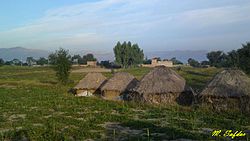Nara, Attock: Difference between revisions
Removed unreferenced content that does not meet with Wikipedia rules Tags: Mobile edit Mobile web edit |
Removed unreferenced and unrequired content that does not meet with Wikipedia rules Tags: Mobile edit Mobile web edit |
||
| Line 45: | Line 45: | ||
Ethnically, Nara's inhabitants of the village can be divided into three groups: local Indians ([[Jats]], [[→Arain← ]] [[Bhati]] [[Rajput]]s, and [[Janjua]] Rajputs), Arabs ([[Awan (Punjabi tribe)|Awans]], [[Khattar (tribe)|Khattar]], and Fatimid Syeds), and Afghans ([[Khattak]] and some Bangash Pathans). [[Hindko dialect|Hindko]] is spoken in Nara, with some [[Pashto language|Pashto]]. Most of the village dwellers follow [[Sunni]] [[Hanafi]] Islam. [[Barelvi]] Sunnis, [[Deobandi]] Sunnis, and [[Shia]]s also live here and there are more than twenty masjids ([[mosque]]s) in the village. |
Ethnically, Nara's inhabitants of the village can be divided into three groups: local Indians ([[Jats]], [[→Arain← ]] [[Bhati]] [[Rajput]]s, and [[Janjua]] Rajputs), Arabs ([[Awan (Punjabi tribe)|Awans]], [[Khattar (tribe)|Khattar]], and Fatimid Syeds), and Afghans ([[Khattak]] and some Bangash Pathans). [[Hindko dialect|Hindko]] is spoken in Nara, with some [[Pashto language|Pashto]]. Most of the village dwellers follow [[Sunni]] [[Hanafi]] Islam. [[Barelvi]] Sunnis, [[Deobandi]] Sunnis, and [[Shia]]s also live here and there are more than twenty masjids ([[mosque]]s) in the village. |
||
==History== |
|||
The name of the village comes from ''Nar'' (نڑ), a bamboo variety common to the region. According to the Punjab Districts’ Gazetteers, [[Awan (Punjabi tribe)|Awans]] claimed the area after driving Janjua Rajputs out of the [[Salt Range]]. |
|||
The area was once used as an avenue for military excursions in India by various Arab, Afghan, Iranian, and Central Asian martial races. Long before that time, the area was used as a gateway for mobility between [[Taxila (ancient)|ancient Taxila]] and the Central Asian states by Buddhists. Hindu traders also settled here and their remains can be found in the center of the village in the form of multi-storey buildings and some ancient Hindu temples (Dharamsaala). |
|||
During the [[Partition of India|pre-partition era]], the British government of India heavily recruited army men from Nara. According to the Punjab [[District Gazetteer]],<ref>[http://www.panjabdigilib.org/webuser/searches/displayPage.jsp?ID=1710&page=1&CategoryID=1&Searched= Punjab Digital Library]</ref> the then-Sikh emperor of Punjab Maharaja [[Ranjit Singh]] convinced local chiefs of Tehsil Jand, mainly Maliks and Khans, to send armed men to crush the Mujahideen Movement, led by Syed Ahmed Shaheed in Balakot. In return, the chiefs were awarded with thousands of kanals of land and other land revenue concessions. The Muhajir community settled in Nara after the partition of India in 1947. Nara became electrified in 1964. The construction of Nara-Jand Road is attributable to Abdul Maalik, who located Indian plane hijackers during the 1970s.<ref>[http://www.myattockcity.com/index.php/2013-03-03-02-06-38/jand-city-histroy/42-jand-city-information/313-jand-histroy-and-information-page-2 Jand History and Information]</ref> |
|||
==References== |
==References== |
||
Revision as of 11:36, 1 October 2018
This article needs additional citations for verification. (April 2013) |
Nara | |
|---|---|
 Rural landscape of Village | |
| Coordinates: 33°41′33″N 72°27′12″E / 33.69250°N 72.45333°E | |
| Country | Pakistan |
| Province | Punjab |
| District | Attock |
| Tehsil | Jand |
| Time zone | UTC+5 (PST) |
Nara (ناڑہ) is a village and union council of Jand Tehsil, Attock District, Punjab Province, Pakistan.
Location
Nara is located 117 kilometers from Islamabad. It is situated five kilometres from the Indus River (دریائے سندھ) on the border between the Punjab and Khyber Pakhtunkhwa provinces of Pakistan.
Demographics

Approximately forty thousand people live in Nara. The literacy rate among village inhabitants is around 70 percent. Internet usage in the village is less than one per cent. Teledensity ratio in the village is around 75 per cent, including 5-7 per cent landline telephone subscribers.





Ethnically, Nara's inhabitants of the village can be divided into three groups: local Indians (Jats, →Arain← Bhati Rajputs, and Janjua Rajputs), Arabs (Awans, Khattar, and Fatimid Syeds), and Afghans (Khattak and some Bangash Pathans). Hindko is spoken in Nara, with some Pashto. Most of the village dwellers follow Sunni Hanafi Islam. Barelvi Sunnis, Deobandi Sunnis, and Shias also live here and there are more than twenty masjids (mosques) in the village.

